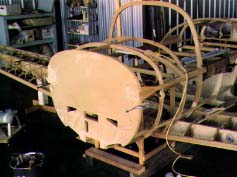The Falco is made of wood. The ribs, spars and fuselage frames are made
of fine-grained Sitka spruce and then faced with aircraft-grade birch plywood.
The entire airplane is skinned with birch plywood. The interior surfaces
are coated with epoxy, and the outside is covered with a very thin layer
of fiberglass and epoxy for moisture protection.
In many ways, the Falco is like building a balsa-wood model, only this
one is full-size. Wood is a pleasure to work with, and anyone can do it.
No special skills or equipment are needed. With wood you can build an aircraft
of unequaled beauty, and a well-designed wood structure, like the Falco,
is very light. Wood even smells nice.
The technology of wood is well-understood and proven over time. Using
any of the traditional aircraft materials -- aluminum, wood, steel tubing,
dope and fabric -- a homebuilder can produce a structure of high quality and
consistency. As good as any factory.
This is not true of all aircraft construction methods. Metal-to-metal
bonding requires sophisticated surface preparation. Composites require heat
and pressure during fabrication and bonding, or the variation in strength
is unacceptably high. That's why Boeing, McDonnell Douglas, Sikorsky, and
all the other leaders in composite construction go to such expense in manufacturing
and testing. In fact, you won't find structural parts in FAA-certified aircraft
built any other way.
So, we're sticking with Sitka spruce and birch plywood, and it suits
us just fine, thank you. Wood is still one of the very best materials for
aircraft construction, and it's the material of choice for competition aerobatic
planes, which need wood's strength and freedom from fatigue. |
![]()
